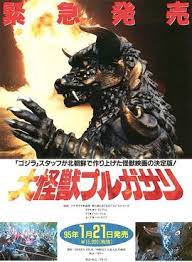
In Korea, during the feudal period, a ruthless Governor (Pong-ilk Pak) is having trouble with bandits. He has his men take all the iron tools and cooking pots from the local people and bring them to the village blacksmith, Takse (Gwon Ri), to make weapons for his soldiers. Takse defies the Governor and gives the tools back to the people. The blacksmith is thrown in jail and left to starve.
His daughter, Ami (Chang Son Hui) and his son Ana (Jong-uk Ri) are not allowed to help him or bring him food. They throw rice into Takse’s cell. Knowing that he is dying anyway, Takse shapes the rice with some mud into a small statue of a mythical creature called Pulgasari and prays that the gods save his people. Ami finds the figure when her father’s body is given back to her.
While trying to sew a tear in Ana’s shirt, Ami pricks herself with the needle. A drop of blood lands on the figure bringing it to life, bonding the creature to Ami. Pulgasari begins eating iron and steel. As he does, he rapidly grows to giant size. With Pulgasari at their sides, the peasants storm the Governor’s palace and kill him. The King is outraged and brings in his best general, General Fuan (Riyonun), to crush the rebellion. With the creature’s help the general’s army is sent fleeing for their lives. The general tries several ways to destroy Pulgasari but to no affect. Pulgasari eventually helps the peasants triumph; however, with the king defeated the peasants find themselves with a bigger problem.
“Pulgasari” was released in 1985 and was directed by Shin-Sang-ok. The film was released in South Korea in 2000. It made its American debut in 2006 in New York. It is a North Korean horror kaiju monster movie and is sort of like Korea’s answer to Japan’s “Godzilla”. The film was based on a 1962 South Korean film called “Bulgasari” that is now considered lost. The film was produced by Kim Jong Il prior to becoming the leader of North Korea. Although it is technically not a public domain movie it is treated as such since Kim Jong Il and his successor Kim Jong Un don’t play nice.
Kim, whose father Kim Il Sung was the supreme leader of North Korea at the time, was a big fan of Hollywood and cinema in general. Reportedly, he amassed a bootleg collection of over 15,000 films. Kim wanted to direct his own films but found that North Korean actors and crews were not as good as those in other countries. In 1978 Kim had South Korean film director Shin Sang-ok and his ex-wife, actress Choi Eun-hee, kidnapped and forced them to make films for him. Most of them were propaganda films but the last film Shin made for Kim before he and Choi escaped to the west was “Pulgasari”. The couple finally escaped in 1986.
Most of the film is on the PG side but there are a couple of torture sequences that seem a little closer to the truth to be comfortable. The monster is, of course, a guy in a suit. In this case it is Kenpachiro Satsuma. Satsuma played Godzilla in the Heisei series of films. As far as monsters go, Pulgasari is basically on par with Godzilla, if a bit cumbersome at times. Although the behind-the-scenes story of Shin Sang-ok is far more interesting than the movie, the film itself does show his talent as a director. The film is supposedly a metaphor for capitalism.
The creature is part of Korean legend. A Pulgasari or Bulgasari is a metal eating creature that is part bear, elephant, rhino, tiger and bull. The more it eats the bigger it gets. Supposedly it was created by a Buddhist monk on the run from the law. The legend differs on if the creature was ever killed or if it still exists.

